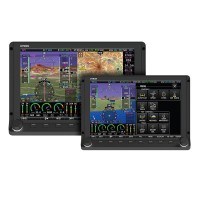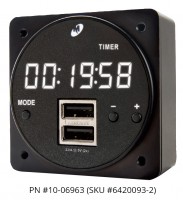BendixKing Aerocruze 100 Digital Autopilot System For Cessna
Overview
|
The AeroCruze 100 is an affordable and flexible digital autopilot system for Cessna 172, 175, 177, 180, 182, and 185 aircraft. The AeroCruze100 provides a seamless integration with the AeroVue Touch EFIS as well as a variety of other manufacturers. The complete system is offered at a low cost, with the choice of three form-factor variations:
Emergency autopilot level button helps to bring the aircraft to a wings-level position. Connects to either hand-held GPS or IFR panel mount GPS systems. When connected to hand-held GPS, follows programmed flight plans. When connected to panel mount GPS, autopilot follows roll steering commands to fly complex flight plans Similar to lane assist in automobiles, the AEP stand-by mode monitors aircraft bank angle. Autopilot corrects the bank angles greater than 45 degrees by automatic roll command. |
Standard Features
- Bank Angle Select (if no GPS signal)
- Track Select
- GPS Nav (point to point type flight plans)
- GPSS (roll steering commands)
- Vertical Speed Select
- Altitude Hold
- Altitude Select
- Altitude Pre-Select
- GPSV (LPV Approaches)
- Control Wheel Steering
- Emergency Level
- AEP (Bank Angle Protection Mode)
- Roll Servo
- Pitch Servo
- Install Kit
- Wiring Harness
Specifications
- 12-28 Volt Variants
- 2” Round: 2.5” H x 2.5” W x 5.5” D
- 3” Round: 3.25” H x 3.25” W x 5.5” D
- Flat Pack: 1.6” H x 4.3” W x 6.1” D
Videos
Reviews
I purchased and in stalled this same Auto Pilot 2 years ago. Then under Trutrax name in my 1965 Cherokee 180. This was the best move I could have ever made. IFR flying is so much easier and %100 safer. The Auto Pilot is very stable and solid. Easy to setup Holds altitude and direction effortlessly. In GPSS mode it is very stable and responsive. On approaches if you have LPV GPS It will fly the approach right down to touch down. But I dont advise that. Flying ATC radar vectors and altitudes are a snap. Flying Cross Country its the best. Ive put 120 hrs of Cross Country on the unit without a hint of trouble. For what it does its far cheaper than other more expensive Auto Pilots that perform the same tasks. Go to Flight Aware and search for N8083W. Youll see how stable the system flies
Q&A
Please note, Aircraft Spruce's personnel are not certified aircraft mechanics and can only provide general support and ideas, which should not be relied upon or implemented in lieu of consulting an A&P or other qualified technician. Aircraft Spruce assumes no responsibility or liability for any issue or problem which may arise from any repair, modification or other work done from this knowledge base. Any product eligibility information provided here is based on general application guides and we recommend always referring to your specific aircraft parts manual, the parts manufacturer or consulting with a qualified mechanic.
The AeroCruze 100 system includes: autopilot controller / sensor unit, roll servo, pitch servo, mounting brackets, required AN hardware, emergency level switch, and wiring harness. This is nearly everything required for a complete installation. The only additional things required are: circuit breaker, pitot / static fittings, and the control wheel steering / emergency disconnect button (yoke mounted, RED, momentary contact, normally open, push button.) These additional items can be purchase from Aircraft Spruce.
YES! The BendixKing / TruTrak AeroCruze 100 autopilot is now available for select certified and all experimental aircraft. This is the same product as the TruTrak Vizion.
There are many factors that go into determining how long an installation will take. Plus, labor rates vary significantly across the country / world. However, in general, an autopilot install in aircraft that hasn’t ever had an autopilot will usually take somewhere between 25 and 35 hours. At 20 to 30 hours that will usually cost between $2500 and $3500. When an existing 2-axis autopilot must be removed, expect this time to generally be around 35 to 45 hours.
The dynamic performance of the entire line of xCruze / AeroCruze 100 autopilots is superior to that of any turn coordinator-based system. As a result of digital design these products can be easily configured in flight. This means that critical performance parameters such as system response can be easily optimized in flight. A single autopilot controller can fly a wide range of aircraft from the Lancair IV Turbine to the Kitfox or even a Cessna 172 or Piper PA28. These autopilots fly very well in turbulence. It is not necessary to turn off the autopilot in turbulence.
The AeroCruze / xCruze 100 products are complete stand-alone autopilots and do not require interface to an external attitude source, as is the case with nearly all other autopilot products on the market today. While these autopilots do not require interface to an external attitude source, they can interface with the G5 or Aspen product lines.
The only thing that aerobatics can do is cause an offset in the internal gyros. This can be corrected by a manual gyro-set operation.
The current drain of the autopilot is approximately 1 amp per servo.
The only thing that is required to get the full functionality of any of these autopilots is a GPS RS-232 signal. The RS-232 must be either NMEA 0183 (GPRMC and GPRMB sentence in the data string) or Aviation format. The desired update rate is every second, but the system will function at an update rate as slow as every other second. Additional capabilities and features are available with the addition of ARINC 429 (GPS Steering).
While our autopilots are capable of operation in bank angle mode without a GPS signal it is highly recommended to couple to a GPS. Our autopilots are able to accept signals from a wide range of both current and legacy panel mounted and handheld GPS receivers.
GPS Nav is similar to GPS Steering but not as sophisticated. GPS Nav signals are on the RS-232 output (GPRMC and GPRMB sentence in the data string) from most GPS’s. This is the same RS-232 connection that is required for the autopilot to be functional so no additional wiring is necessary. Virtually all GPS’s (handhelds included) have the output that is required for GPS Nav. GPS Nav flies a preprogrammed route with multiple waypoints. The course intercept feature of GPS Nav allows the autopilot to seamlessly intercept courses regardless of the aircraft’s initial direction of flight. When the last waypoint is flown over the autopilot reverts to the track mode. All of the Vizion / xCruze / AeroCruze 100 autopilots have GPS Nav Mode.
































